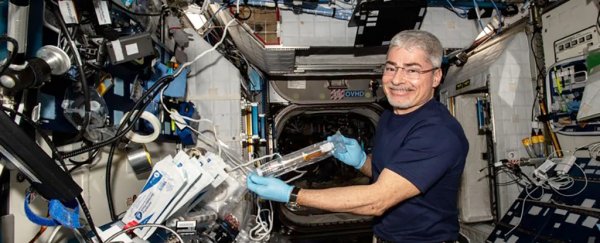NASA astronaut Mark Vande Hei has broken the record for longest US human spaceflight, a title former astronaut Scott Kelly has held since 2016.
Tuesday marks 341 consecutive days in space for Vande Hei, surpassing Kelly's record-breaking 340-day stint aboard the International Space Station (ISS).
But the achievement comes amid volatile relations between the US and Russia in space. Russia has stopped selling rocket engines to the US, following sanctions President Biden imposed in response to Russia's invasion of Ukraine.
Kelly got into a Twitter spat with Russia's top space official, Dmitry Rogozin, who made inflammatory comments about the ISS falling to Earth without Russia's help. SpaceX CEO Elon Musk and astronomer Jonathan McDowell have also sparred with Rogozin online.
Still, NASA officials maintain that operations on the ISS aren't affected by fallout from Russia's invasion of Ukraine. Vande Hei is still poised to return safely to Earth aboard a Russian Soyuz spaceship on March 30.
"Nothing has changed in the last three weeks," Joel Montalbano, NASA's ISS program manager, said in a spacewalk press briefing on Monday.
"I can tell you for sure, Mark is coming home on that Soyuz. We are in communication with our Russian colleagues. There's no fuzz on that."
By the time he lands in Kazakhstan, the astronaut will have spent 355 days in space.
"I don't think it's really my record – I think it would be the whole team's," Vande Hei told Insider in August. "It's just another step forward for humanity. I also don't expect that to be a record that would last very long, because we're doing bigger and better things all the time."
Vande Hei, a former Army colonel from New Jersey and Minnesota, wasn't originally scheduled to stay in space for so long. When he launched to the ISS on a Russian Soyuz spaceship on April 9, 2021, he was planning for a standard six-month shift of spacewalks, science experiments, and station maintenance.
But Vande Hei and his crewmate, Russian cosmonaut Pyotr Dubrov, knew they might do a double shift, stretching their stay to a full year. Russia's space agency, Roscosmos, was launching a film director and actress to the ISS for a week of movie-making. The agency ultimately asked Vande Hei and Dubrov to give the film crew their seats on the spaceship back to Earth. The astronaut-cosmonaut duo would hitch a ride on the next Soyuz ship.
Dubrov will also have spent 355 days in space. But that's not a record for Russia. Cosmonaut Valery Polyakov holds the title for longest continuous human spaceflight, after spending 438 days on Russia's Mir space station in the mid-'90s.
Rogozin's comments left Vande Hei's family 'very worried'
Although Roscosmos and NASA continue to collaborate on the ISS, Rogozin has targeted the station in his Twitter tirades. On February 24, he claimed the ISS would lose orbit and begin an uncontrolled fall to Earth if Russia withdrew its spaceships, which routinely fire their engines to push the ISS higher, a maneuver called a "reboost," after the station loses altitude.
The following week, NASA Watch reported that a Russian state media outlet posted a Roscosmos video to Telegram, including edited ISS footage to make it look like cosmonauts were leaving Vande Hei behind. Insider has not independently verified that the video came from Roscosmos.
Vande Hei's mother, Mary, told The Daily Mail on Sunday that Rogozin was making "a terrible threat."
"When I first heard it, I did a lot of crying. It's very troubling. We are just doing a lot of praying," she told the Mail, adding, "It is really a shame that it's been politicized like this. It's quite a shock."
Vande Hei's wife, Julie, is "very worried," she added.
"These threats are just one person speaking and though it's the head of the Russian space agency, all the other people within the space agency seem very cooperative," Vande Hei's father, Tom, told the Mail, adding, "Our son does not scare easily."
Soyuz spaceships are no longer the only vehicles capable of carrying humans to the ISS. Since 2020, NASA has been using SpaceX Crew Dragon spaceships to ferry astronauts to and from the station.
This article was originally published by Business Insider.
More from Business Insider:
